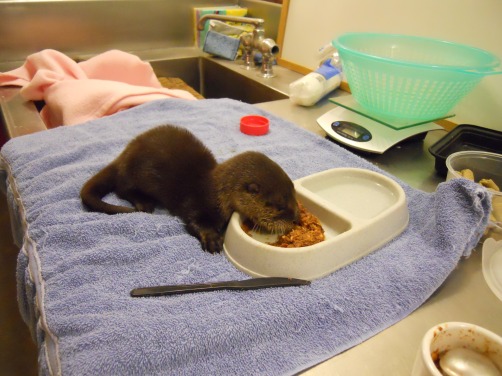Sadly, the baby river otter we admitted yesterday did not make it through the night. She initially rallied a bit after getting warmed up and getting some food and fluids, but after a few hours she began to go downhill. Based on the condition of the mother’s body, she must have been on her own for at least a couple of days, which is a very long time for a baby that is still nursing. She had simply gone too long without nutrition before she was found, and her body began to shut down. She was unable to retain body heat, and no matter what I tried to keep her warm, her temperature continued to fall until finally her heart stopped around 2 AM. Everyone here at TreeHouse was greatly saddened to lose her, but at least, thanks to the care and alertness of the couple who found her, she didn’t die shivering in a drain.
A mother’s care is of paramount importance to the survival of young animals, particularly mammals, and no matter what the circumstances, the odds are stacked against orphans cut off from maternal care. In nature, many animals succumb to weather conditions, predators, and even simply being the runt of the litter. This is the way natural selection works. At TreeHouse, we are able to help so many animals that are victims of both natural and human-caused trauma. Each year, we raise a great many orphaned animals for release back to the wild. It is always incredibly rewarding when we are able to release an animal that was brought to us malnourished and shivering from exposure, and that we nursed back to health and cared for until it was mature and strong enough to survive on its own. Still, it is often the animals that do not make it that really stay with us, and this otter will certainly be one of those for me.
But as always, life goes on at TreeHouse. We received good news today as well–a bald eagle we admitted over the winter with a broken tibiotarsus (equivalent to the shin) from a gunshot went to the vet yesterday and had her cast removed. The eagle is a huge female that came from along the Little Wabash River in Clay County. Although recovery from injuries of this kind is a long process, she is doing well, and as long as she retains enough function in the talons of her injured leg, we are hopeful about her prospects for recovery.
There is always another animal in need of care for an injury, or more babies orphaned and in need of nurturing, and it is simply the nature of wildlife rehabilitation that we will experience emotional ups and downs as we continue to invest ourselves in the care of these animals.


